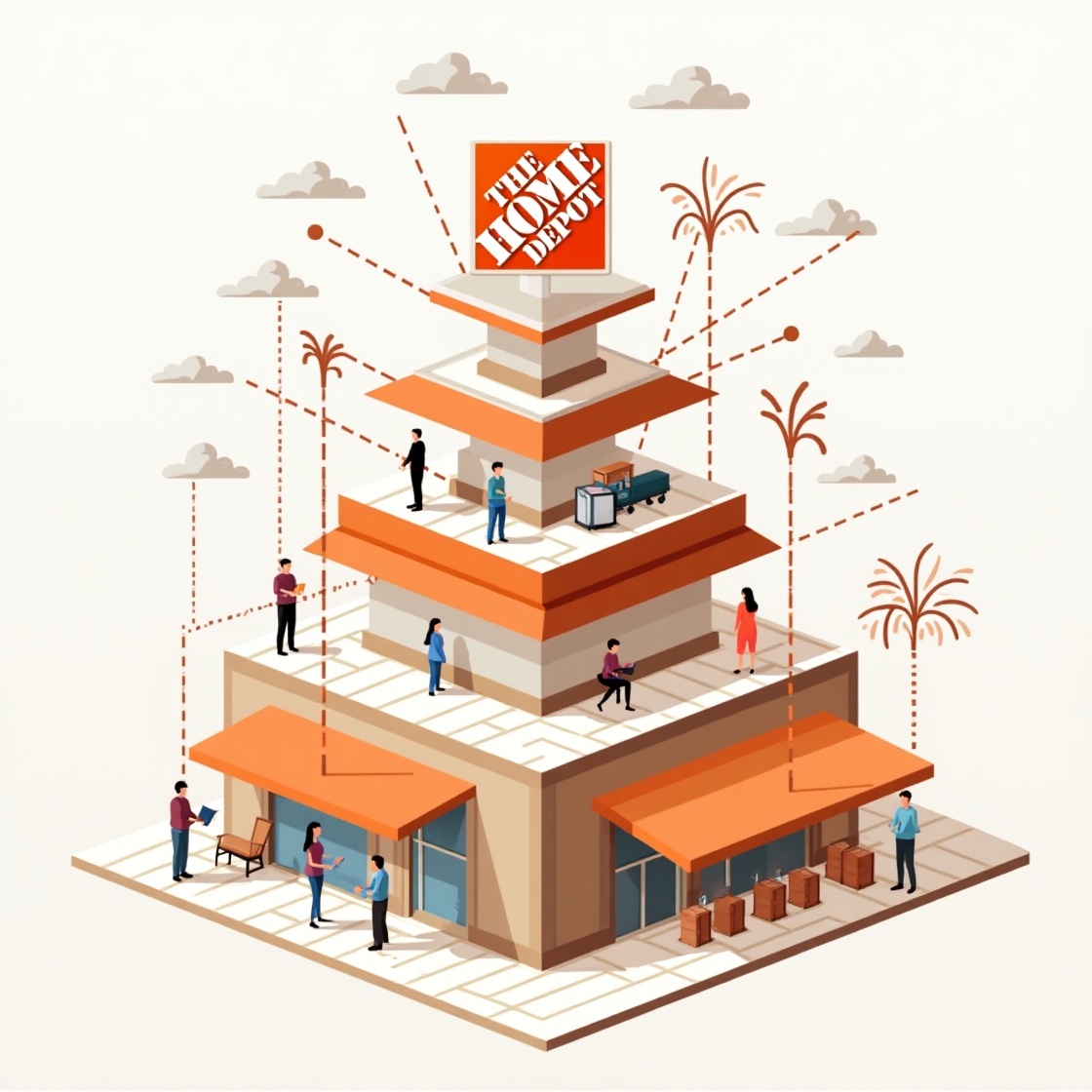You know, walking into a place like The Home Depot can feel a little overwhelming sometimes. It’s so big! Aisles and aisles of wood, tools, paint, plants, everything you can imagine for fixing up a house or working on a project. It’s like a giant warehouse filled with possibility. But have you ever stopped to think about what it takes to make a place that big work smoothly? To make sure the right products are on the shelves, that people are there to help you find what you need, and that the whole operation runs like a well-oiled machine? It takes a lot of planning, a lot of hard work, and most importantly, it takes a whole lot of leadership. Not just one leader at the very top, but many different kinds of leaders working together, all the way down to the people you see walking the aisles in those orange aprons.
Thinking about The Home Depot’s leadership got me thinking about how leadership works in big companies. It’s not just about having one person with a fancy title. It’s more like an orchestra, with different musicians playing different instruments, all following the same conductor to create something amazing. Or maybe like a giant construction project, where you have the architect with the big plan, the engineers figuring out the details, the foremen leading the crews on the ground, and all the skilled workers doing their part. Everyone has a role, and everyone’s leadership matters in their own way.
I remember once, I was working on a business problem that involved understanding how really large companies manage to keep everyone pointed in the same direction. The Home Depot came up as a great example because they are so big and spread out, with stores all over the place, distribution centers, and a huge corporate office. How do they make sure that a store in Florida is operating with the same ideas and goals as a store in California? That a customer in Texas gets the same kind of helpful service as a customer in New York? It all comes down to their leadership structure – how they organize their leaders and what each level of leader is responsible for.
Let’s start at the very top, the folks you might read about in the news. This is where you find the big-picture thinkers, like the CEO, that stands for Chief Executive Officer. Think of the CEO as the head architect of the whole Orange Empire. Their main job is to set the overall vision for the company. Where is Home Depot going in the next five, ten, twenty years? What are the really big goals? Are they going to focus more on online sales? Are they going to open new kinds of stores? The CEO makes those huge decisions about the company’s future. They also set the tone for the company culture – what kind of place is Home Depot to work and shop in? Do they value helping customers above everything else? Do they care about being good neighbors in the communities where their stores are located? The CEO’s ideas and values spread down through the entire company. They work with a small group of other top executives, like the Chief Financial Officer (who manages the money) and the Chief Operating Officer (who oversees how everything actually runs day-to-day). This small group at the very top is responsible for the company’s overall success and making sure they are heading in the right direction in the big, competitive world of retail. Their decisions impact thousands and thousands of employees and millions of customers. They have to think years ahead and understand all the complex things that affect a huge business, like the economy, what competitors are doing, and what customers want. It’s a demanding job that requires a lot of experience and a clear vision for the future.
Beneath that top level, you have leaders who are responsible for connecting that big-picture vision to the many different parts of the company. Think about all those stores spread across the country. You can’t have the CEO directly managing every single store manager – that would be impossible! So, there are layers of leadership in between.
You have what you might call mid-level managers. These leaders are like the engineers who take the architect’s big plans and figure out how to make them actually happen in different areas. At Home Depot, this includes people like Regional Vice Presidents and District Managers. A Regional Vice President might be in charge of Home Depot stores in a large area, like the entire southeastern United States. They work to make sure all the stores in their region are following the company’s main plans and goals. They might be responsible for making sure sales are strong in their region, that stores are operating safely, and that leaders in those stores have the support they need from the corporate office.
District Managers have a smaller area, maybe overseeing 10 or 15 stores in a specific city or part of a state. They are like the project managers for their group of stores. They visit the stores regularly, talk to the store managers, look at the store’s performance numbers, and help solve problems that a single store manager might not be able to handle alone. They make sure that the company’s plans and goals are being put into action correctly in each of their stores. They are the key link between the top leaders and the people who are actually running the stores every day. They need to understand the big company goals and figure out how to translate those goals into actions that make sense for the specific stores in their district, dealing with local challenges and opportunities. It’s a job that requires a lot of travel, strong communication skills, and the ability to support and guide multiple store leaders.
Now, let’s move closer to the ground level, the leaders you see most often when you visit a store. Every Home Depot store has a Store Manager. This person is like the general contractor for that specific location. They are in charge of everything that happens in that store. They are responsible for making sure the store looks good, that the shelves are stocked, that customers are happy, that the employees are doing their jobs well, and that the store is making money.
The Store Manager is a really important leader because they are the face of Home Depot in their local community. They lead a large team of employees, hire new people, train them, manage schedules, handle customer complaints, and make sure the store meets all the company’s standards. They have to be good at many different things – managing people, understanding sales numbers, knowing about the products, and creating a positive environment for both customers and employees. They are the key leader who makes sure the customer experience is good and that the store runs smoothly day in and day out. They work closely with their District Manager but have a lot of responsibility for the success of their specific store. They often have to deal with unexpected issues, like a sudden rush of customers because of a big storm, or a problem with a delivery. They need to be quick on their feet and good at solving problems while keeping their team focused and motivated.
Under the Store Manager, there are other layers of leadership within the store itself. You have Assistant Store Managers, who help the Store Manager with the big-picture stuff and often take charge of the store when the main manager isn’t there. They might be responsible for specific areas of the store’s operations, like the front end (cashiers and customer service) or the night shift.
Then, you have the Department Supervisors. These leaders are like the foremen for specific areas within the store, like the lumber department, the gardening center, the paint department, or the tools section. They are experts in their specific area, and their job is to lead the team of employees who work in that department. They make sure their department is well-stocked, that the employees know about the products and can help customers, that the department looks good, and that it meets its sales goals.
Department Supervisors are important because they are the direct leaders for many employees. They train new people in their department, create their schedules, help them with difficult customer questions, and make sure they are doing their jobs correctly and safely. They need to be good at working with people, motivating them, and making sure their specific area of the store is successful. They are on the front lines, working closely with the employees and interacting with customers constantly. They need to be able to quickly answer questions, solve problems, and keep their team focused on providing great service in their specific part of the store. They also work closely with the Store Manager and Assistant Managers, reporting on how their department is doing and getting support when needed.
Finally, there’s another kind of leader at Home Depot that doesn’t always have a formal title or a manager role on paper, but whose leadership is just as important. These are the informal leaders among the regular employees, the associates you see in the orange aprons. These are often employees who have been with the company for a long time, who know the store inside and out, who are great at helping customers, and who are always willing to help their coworkers.
These informal leaders might not have people directly reporting to them, but they lead by example. They show newer employees how things are done, they share their knowledge about products, they step up to help solve problems, and they often set a positive tone for the team around them. Other employees look up to them, ask them for advice, and follow their lead because they trust them and respect their experience and helpful attitude. This kind of leadership is incredibly valuable in a large store environment because it helps build a strong team spirit and ensures that knowledge is shared among employees, which directly helps customers. It’s the kind of leadership that happens naturally when people are committed and care about their work and their team. They are the go-to people when someone needs help finding a tricky item or figuring out how a tool works. They often embody the best of the company’s values through their everyday actions.
So, when you look at The Home Depot, you see this whole structure of leadership, like layers in a building or different parts of a tree. At the top, the executives are setting the big plans, like the roots and the trunk providing the main support. Then you have the mid-level managers, like the big branches, connecting those plans to different regions and districts. The store managers are like the smaller branches, leading each individual store. The department supervisors are like the twigs, leading specific areas within the store. And the informal leaders among the associates are like the leaves, spread throughout the entire tree, making sure everything is working well on the front lines, helping things grow and stay healthy.
All these different types of leaders, at their different levels, have really important jobs to do. The executives need to be good at thinking about the future and making big decisions. The regional and district managers need to be good at organizing and supporting many different stores. The store managers need to be good at running a complex operation and leading a large group of people. The department supervisors need to be good at managing their specific area and leading their small team. And the informal leaders among the associates need to be good at helping others, sharing knowledge, and setting a positive example.
It’s the way these different leaders work together that makes a huge company like Home Depot successful. The plans from the top need to be clearly communicated down through the layers. The feedback and ideas from the people working in the stores need to be shared back up to the top so the company can learn and improve. It’s a constant flow of information and guidance.
Leading at Home Depot, at any level, means understanding the company’s goals, knowing your specific responsibilities, being able to work well with people, and being committed to helping customers. The store manager can’t run the store without good department supervisors, and the department supervisors can’t succeed without motivated and capable associates. Everyone’s leadership, in their own role, is necessary.
Thinking about leadership in a big company like this teaches us a few things. It shows that leadership isn’t just about being the boss; it’s about taking responsibility, guiding others, and helping the team or the company achieve its goals, no matter where you are in the organization chart. It shows the importance of having clear roles for leaders at different levels, so everyone knows what they are responsible for. And it shows that great companies are built on the strength of many leaders, formal and informal, all working together towards a common purpose.
So, the next time you walk into a Home Depot, take a moment to look around. Beyond the tools and the lumber, think about the many layers of leadership, the different people in orange aprons and behind the scenes, all working together, leading in their own way, to build and maintain that massive “Orange Empire.” It’s a real-world example of how leadership, spread throughout an organization, makes a big difference in making a company successful and keeping it running smoothly. It’s a testament to the power of leadership at every level.
What do you think about the different kinds of leaders in a big company? Have you seen examples of great leadership at different levels in places you’ve worked or shopped? Share your thoughts in the comments below!



